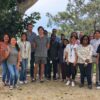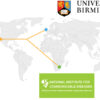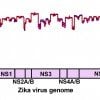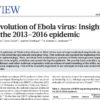Wastewater surveillance is a cost-effective, convenient tool for tracking harmful pathogens circulating through the population, but technology and infrastructure hurdles have limited its widespread use. The Bill & Melinda Gates Foundation has awarded Scripps Research a $1.5 million grant to overcome these barriers, expand wastewater surveillance tracking, and help mitigate infectious disease threats around the globe.
The two-year award, which funds a collaboration between Scripps Research, the National Institute for Communicable Disease (NICD) in South Africa, and the University of Birmingham in England, will help build the tools needed for effective infectious disease wastewater surveillance across the world. A particular focus will be on developing and implementing these technologies in lower middle-income countries, many of which have large surveillance gaps.
“In an era where global health threats can emerge swiftly and silently, wastewater surveillance offers a way to identify viruses and other pathogens in a rapid and affordable way,” says Kristian Andersen, PhD, project lead of the grant and professor in the Department of Immunology and Microbiology at Scripps Research. “Working with top scientists at the NICD and University of Birmingham, this grant will enable us to continue building the tools needed to track and analyze a broad range of pathogens, especially in contexts with limited clinical testing.”
It’s been historically difficult to identify different pathogens using wastewater genomic surveillance, since a single wastewater sample can contain numerous viral strains, the majority of which are fragmented. Many of the standard bioinformatic tools used to identify pathogens are intended for sequencing individual clinical samples (like swabs or blood tests), rather than sorting through these complex, highly fragmented mixtures of pathogen genomic material.
Over the last year-and-a-half, scientists in Andersen’s lab have been collaborating with the NICD to develop and implement novel computational tools and laboratory methods for improved wastewater surveillance and working to identify SARS-CoV-2 variants of concern in South African wastewater. Many of the protocols and technologies these groups have developed are already being used today among public health experts and academic researchers, notably for sequencing and analyzing SARS-CoV-2 in the community. Last year, Andersen’s lab also collaborated with the Rob Knight lab at UC San Diego, publishing a Nature study showing that wastewater could be used to detect SARS-CoV-2 variants circulating, as well as identify lineages that didn’t appear in clinical sampling.
Now, with the new award, the researchers will extend these computational tools to monitor many other pathogens, such as measles virus, rubella virus, seasonal and avian Influenza, and Hepatitis A/E viruses.
“We came up with a bioinformatics method that allows us to recover the fractions of the different SARS-CoV-2 lineages circulating in wastewater, which nicely complements typical clinical surveillance approaches,” says Joshua Levy, PhD, a postdoctoral fellow in Andersen’s lab leading the project. “With this funding, we can now expand our tools to track many other pathogens, both across San Diego and South Africa.”
The grant has three distinct aims: The first will be to develop the right schemes, protocols and bioinformatics tools to monitor these additional pathogens, while also expanding surveillance capabilities in South Africa. The second aim is to help standardize practices and methods for the wastewater surveillance field, ensuring findings are translatable across different collection sites. Finally, the third aim involves extending Freyja—a software resource developed in Andersen’s lab—to computationally analyze and visualize wastewater sequencing data for multi-pathogen surveillance. Freyja is an open-source tool that is fully available to the public, currently with more than 100,000 downloads.
“One of our key objectives is to develop tools and protocols that are freely available, easily implemented, and broadly interpretable anywhere,” Levy adds. “This open-source approach helps ensure that researchers around the world can monitor for public health threats, regardless of borders or demographics.”








